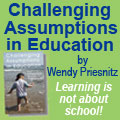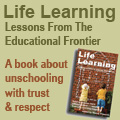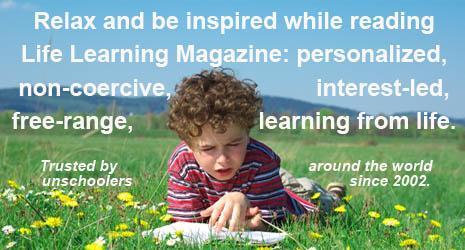|

Getting Over Math:
Learning Math in the Real World
By Anna Hoffstrom
A few months ago, I found myself on a shopping trip in Helsinki. Finland – where I live – is a pretty small country, all things considered, and Helsinki is the only decent place to get some good clothes. Even more importantly, it’s the only good place to buy some good books. The garden shelves caught my attention first, but not for long. I moved onward, skipped the math section, and looked at books on literature, then business, then history. I browsed almost every shelf, and enjoyed every minute of it. But I still didn’t look at any of the math books. Good riddance, I thought. I didn’t need them anyway.
I was browsing the paperback science section when I found a book I thought I would buy. It was about Nature’s symmetry, something I’ve always found fascinating. It’s something we’ve all come across: You find it in starfish, snowflakes, the seedpods of an apple, leaves, and even, perhaps especially, in ourselves. Even our brains are wired to find symmetry beautiful. It took me a minute to realize I was reading a math book. After another, I realized I didn’t mind reading about math after all.
Why Math Matters
Conventional schooling tells us every child deserves an equal opportunity, and I agree. Children do deserve equal opportunities. School just has a funny way of showing it, especially when it comes to math.
When I was in school we had math almost every day, even in elementary school. It was a fifty-five minute block of the day for six years of my life, and it quickly became my least favorite subject. The numbers we practiced and counted and learned about were so detached from everything else that it seemed pretty pointless.
“Everyone deserves an equal opportunity,” the teachers would parrot out. “You might need this math if you want to become a scientist someday.”
Sometimes the profession they mentioned would change, but otherwise the message was the same: You might need this, and so we’re giving everyone an equal opportunity by teaching everyone the same thing. Yeah. Right.
Math does matter. It just isn’t because every child deserves an equal chance at becoming a scientist. Or a doctor. Or a lawyer. Or whatever profession your teacher liked to tell you about. Math matters because it isn’t arbitrary. If you asked me, schools wouldn’t suffer at all if math was dropped completely from the curricula and integrated into other subjects.
I’m life learning now, so school curriculum doesn’t matter much to me anymore. But all of a sudden, I find that math does. After I came home with my shiny new book on Nature’s symmetry, it felt like a dam had been broken. I finally opened my eyes to the fact that everything I am interested in, from cooking to electronics, is related to math. In real life you don’t have to worry about integrating math into other subjects. In real life, math already is integrated into everything else.
Math in the Real World
After I saw that math isn’t anything like school makes it out to be, I realized I had gotten a very short end of the stick. School had gone about it all wrong, and I had missed out because of it.
I have to ask, what if a different topic was taught in schools the way math is taught? What if, for example, art class was? Try to imagine it. It would be difficult to enjoy art if all you learned about was color theory and artist biographies, never created your own art, and never saw the masterpieces you read about. What if art class was nothing but repeating the same brush strokes and shading techniques over and over?
What would you tell someone who thought that was all there was to art? I’d have to tell them that they didn’t know about art at all. So I have to ask another question: What makes math so different? And yet, despite the unrealistic way math is presented in schools, so many of us find ourselves respecting those methods and believing that’s how math is. Instead of thinking that math is being presented in the wrong way, we blame ourselves for not understanding it.
There are so many examples that make it obvious that art is much more than brush strokes and shading techniques. Luckily for us, math also has its own real world examples that show us just how beautiful math can be.
One example is symmetry, as my new book showed me. It’s a subject that is all math, even if Nature’s way of showing it is pretty visual. When I look at starfish or the perfect proportions of a shell, I don’t think about math. Reading a book on Nature’s symmetry has yet to make numbers dance around in my head when I look at the world around me, but I still appreciate things just a little bit more. The math part is just there, a small part of my whole understanding.
Symmetry is just one thing on a long list of real world examples of math. Looking back at that shopping trip last fall, I realize now that all the books I looked at had some bit of math in them. And if nothing else, I had to count out how much everything would cost.
Even now, as I sit at my desk and write this, the things that are within arm’s reach are related to math in some way or another. My computer, for one, wouldn’t work without all the mathematical equations making sure it works right. My desk itself wouldn’t be so sturdy without the math that it took to design it. Even my body, something I usually take for granted when everything is working right, can be described and explained with numbers.
And that’s just the start. Here are a few real-world examples of math that we come across every day:
Color and Light: Electromagnetic radiation is a form of energy that moves in waves as it travels through space. Radiation can be a scary word, but visible light and the colors that it produces is a form of electromagnetic radiation. Different colors are determined by the different frequencies and wavelengths of the electromagnetic radiation.
The visible color spectrum ranges from violet, blue, cyan, green, yellow, and orange, to red. From left to right the frequency of the waves decreases as the wavelengths increase, and that’s what changes our perception of color. Humans are most sensitive to green light, which is smack dab in the middle of the visible spectrum. A great example of our sensitivity to green can be found in green laser pointers: In the dark, the entire beam of a green laser pointer is visible. A red laser pointer of the same strength would only show up as a dot as it hit a solid object.
Gravity: We all learn from a very young age that when you drop something it will keep falling until a solid surface stops it. Gravity is the word used to describe the rate of acceleration near or on a body’s surface, and Earth’s gravity accelerates falling objects at a rate of 9.81m/s2. This explains why objects fall, why falling from a greater height hurts more than from a shorter one, and why different objects fall at the same rate. It also explains why our weight would be different on other planets and moons, since their gravitational forces are different. On Earth’s moon, which has a force of 1.63m/s2, we weigh only 16.6 percent of our “Earthly” weight. Someone who weighs 150 pounds on Earth would weigh just short of 25 pounds on Earth’s moon. No wonder astronauts bounce so high!
Games: All of us have played some game or another and, whether we’re talking about Monopoly or World of Warcraft, games have always had a deep connection with math. We give points to the winners, compare weapon damage, budget our money, and work for experience so we can level up. The list is endless. In games like World of Warcraft, the entire digital world is based on math, much like our real world is. The more complicated the game, the more math there is.
Music: Music and math have the reputation of being the world’s two international languages. No matter where you are or what language you speak, math and music are understood without translating musical notes or numbers. To make it even more interesting, music can be analyzed with math. There’s even an entire branch of study behind the physical properties of music, called musical acoustics. Some composers have gone as far as using math to help compose their music. A prominent example is the French composer Erik Satie, who used the golden ratio in many of his pieces.
Cooking: Not all of us are cooks, but all of us eat. Even if you’re a raw foodie, your food relates to math. The math of food doesn’t stop at pie fractions, either. It can be as complicated as explaining the chemical reactions in yeast or the nutritional requirements for an individual, but we come across the simple equations of food every day.
We keep our freezers and refrigerators and our pantries at the right temperatures. We have best before dates on our food because of the rate food starts to break down. We have to cook certain foods, especially meat and eggs, at the right temperatures in order to kill bacteria and break down proteins to an edible degree. A sweet cookie is only so many numbers away from being sourdough bread. Aren’t you glad math makes it easier to know the difference?
Gardening: If you’ve ever set up your own garden, you’ll know that quite a bit of math can be involved. The area of your garden plot is calculated, you have to space your seeds correctly, and troubleshooting the problems your plants face can relate to anything from hours of sunlight to the amount of nitrogen in the soil. Even better, I’m sure all of you have heard about photosynthesis. That’s quite an equation in itself, and without the photosynthesis in plants, we wouldn’t have oxygen. It’s harder to get more mundane than the very air we all breathe!
Unschooling Math
It doesn’t take much to see that math is all around us. It’s in the air we breathe, the food we eat, everything that we can see and hear and smell, and even the things too big or too small for us to appreciate. Math isn’t just theory, it’s life. It’s there whether we notice it or not.
Having said all of that, let me remind you that math was never my favorite subject in school. When I started life learning, I relished the fact that I didn’t have to think about it if I didn’t want to. For a long time, I ignored it completely. I knew the basics, I had a trusty calculator, and I didn’t need anything else.
I had been life learning for two years when it finally clicked that math wasn’t as pointless as I had thought it was, but math hadn’t magically disappeared for the two years I ignored it. Math was always there in the background. I didn’t have to deliberately focus on math in order for it to be part of my life. Math affected it all the same. A lot of new life learners, and even some people I know have been out of school for a while, worry about math. After my experience, I’ve stopped worrying about it. I want to let you know you can, too.
If you’re worried you can’t learn math informally, I have a simple exercise for you. You don’t even need to get out of your chair to try it:
Step One: Look for math in the things you normally enjoy doing.
Step Two: Ask yourself if the math part of what you enjoy doing makes any difference. For example, does the insane amount of biological symmetry in a starfish make it any less interesting to look at?
You don’t have to change the way you spend your day in order to come across math. If you look for it, you’ll realize it’s already there. In my opinion, knowing more about the math that has been lurking behind the scenes makes the things I enjoy even more awe-inspiring.
Unless you have a math phobia, I don’t see many of you changing your everyday lives just because there’s a bit of math involved in your favorite foods or the games you like to play. But here’s the big question: If you can find math in your everyday life, why is math any different from any other “subject” encountered by life learners? That’s just the thing. It isn’t.
We all learn at our own pace, and math will make itself known to all of us one way or another. So take a deep breath, and don’t worry. Math is as much a part of everyday real life as anything else and no child will be able to ignore his or her curiosity about numbers for long.
Getting Over Math
Math doesn’t have to be a big purple polka-dotted elephant in the living room that we’re all doing our best to ignore or tolerate. It isn’t math that’s the problem; it’s our general attitude about it that’s all wrong. And only we have the power to change that attitude in ourselves.
The most fascinating thing about math, in my opinion, is that we didn’t make it up. Brush techniques are something humans developed. Instruments are something we invented. But math is something that already exists, and we’re doing little more than discovering it. It’ll always be there, and it always has been. It’s like a treasure hunt, and the prize is a better understanding of the world around us. As a life learner, I find that pretty hard to resist.
A lot of us have a bad relationship with math. I used to, but I got over it. Real life can’t be divided into subjects. You can’t ignore math without missing out on everything else. Without getting up, look around you. Can you find something within arm’s reach that isn’t related to math in some way or another? Neither could I.
Anna Hoffstrom is a writer and was an eighteen-year-old unschooler living in Finland when she wrote this article. She went to public school until the age of sixteen.
Copyright © Life Media
Privacy Policy
  
  

|

